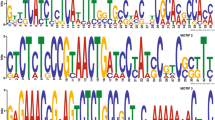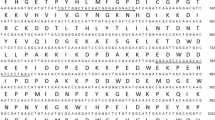Abstract
Three cystatin open reading frames named TcCys1, TcCys2 and TcCys3 were identified in cDNA libraries from compatible interactions between Theobroma cacao (cacao) and Moniliophthora perniciosa. In addition, an ORF named TcCys4 was identified in the cDNA library of the incompatible interaction. The cDNAs encoded conceptual proteins with 209, 127, 124, and 205 amino acid residues, with a deduced molecular weight of 24.3, 14.1, 14.3 and 22.8 kDa, respectively. His-tagged recombinant proteins were purified from Escherichia coli expression, and showed inhibitory activities against M. perniciosa. The four recombinant cystatins exhibited K i values against papain in the range of 152–221 nM. Recombinant TcCYS3 and TcCYS4 immobilized in CNBr–Sepharose were efficient to capture M. perniciosa proteases from culture media. Polyclonal antibodies raised against the recombinant TcCYS4 detected that the endogenous protein was more abundant in young cacao tissues, when compared with mature tissues. A ~85 kDa cacao multicystatin induced by M. perniciosa inoculation, MpNEP (necrosis and ethylene-inducing protein) and M. perniciosa culture supernatant infiltration were detected by anti-TcCYS4 antibodies in cacao young tissues. A direct role of the cacao cystatins in the defense against this phytopathogen was proposed, as well as its involvement in the development of symptoms of programmed cell death.







Similar content being viewed by others
Abbreviations
- BSA:
-
Bovine serum albumin
- PLCPs:
-
Papain-like cysteine proteases
- PCD:
-
Programmed cell death
- NEP:
-
Necrosis and ethylene-inducing proteins
- ORF:
-
Open reading frame
- BApNA:
-
Nl-alpha-benzoyl-dl-arginine-p-nitroanilide hydrochloride
References
Abe M, Abe K, Iwabuchi K, Domoto C, Arai (1994) Corn cystatin I expressed in Escherichia coli: investigation of its inhibitory profile and occurrence in corn kernels. J Biochem 116:488–492
Aime MC, Phillips-Mora W (2005) The causal agents of witches’ broom and frosty pod rot of cacao (chocolate, Theobroma cacao) form a new lineage of Marasmiaceae. Mycologia 97:1012–1022
Altschul SF, Madden TL, Schaver AA, Zhang J, Zhang Z, Miller W, Lipman DJ (1997) Gapped BLAST and PSI-BLAST: a new generation of protein database search programs. Nucleic Acids Res 25:3389–3402
Andebrhan T, Figueira A, Yamada MM, Cascardo J, Furtek DB (1999) Molecular fingerprinting suggests two primary outbreaks of witches’ broom disease (Crinipellis perniciosa) of Theobroma cacao in Bahia, Brazil. Eur J Plant Pathol 105:167–175
Arai S, Matsumoto I, Emori Y, Abe K (2002) Plant seed cystatins and their target enzymes of endogenous and exogenous origin. J Agric Food Chem 50:6612–6617
Barrett AJ (1976) An improved color reagent for use in Barrett’s assay of cathepsin B. Anal Biochem 76:374–376
Barrett AJ (1994) Classification of peptidases. Methods Enzymol 244:1–15
Belenghi B, Acconcia F, Trovato M, Perazzolli M, Bocedi A, Poticelli F, Ascenzi P, Delledonne M (2003) AtCYS1, a cystatin from Arabidopsis thaliana, suppresses hypersensitive cell death. Eur J Biochem 270:2593–2604
Bradford MM (1976) A rapid and sensitive method for the quantification of microgram quantities of protein utilizing the principle of protein–dye binding. Anal Biochem 72:248–254
Carvalho HAS (2007) Biochemical and molecular analyses of protease from the interaction Theobroma cacao–Moniliophthora perniciosa. Masters dissertation, Universidade Estadual de Santa Cruz, Brazil
Ceita GO, Macêdo JNA, Santos TB, Alemanno L, Gesteira AS, Micheli F, Mariano AC, Gramacho KP, Silva DC, Meinhardt L, Mazzafera P, Pereira GAG, Cascardo JCM (2007) Involvement of calcium oxalate degradation during programmed cell death in Theobroma cacao tissues triggered by the hemibiotrophic fungus Moniliophthora perniciosa. Plant Sci 173:106–117
Chan YL, Yang AH, Chen JT, Yeh KW, Chan MT (2010) Heterologous expression of taro cystatin protects transgenic tomato against Meloidogyne incognita infection by means of interfering sex determination and suppressing gall formation. Plant Cell Rep 29:231–238
Chichkova NV, Kim SH, Titova ES, Kalkum M, Morozov VS, Rubtsov YP, Kalinina NO, Taliansky ME, Vartapetian AB (2004) A plant caspase-like protease activated during the hypersensitive response. Plant Cell 16:157–171
Christova PK, Christov NK, Imai R (2006) A cold inducible multidomain cystatin from winter wheat inhibits growth of the snow mold fungus, Microdochium nivale. Planta 223:1207–1218
Diop NN, Kidric M, Repellin A, Gareil M, d’Arcy-Lameta A, Pham Thi AT, Zuily-Fodil Y (2004) A multicystatin is induced by drought-stress in cowpea (Vigna unguiculata (L.) Walp.) leaves. FEBS Lett 577:545–550
Evans HC (1980) Pleomorphism in Crinipellis perniciosa, causal agent of witches’ broom disease of cocoa. Trans Br Mycol Soc 74:515–523
Freitas-Filho D, Pungartnik C, Cascardo JMC, Brendel M (2006) Broken hyphae of the basidiomycete Crinipellis perniciosa allow quantitative assay of toxicity. Curr Microbiol 52:407–412
Garcia O, Macedo JA, Tibúrcio R, Zaparoli G, Rincones J, Bittencourt LM, Ceita GO, Micheli F, Gesteira A, Mariano AC, Schiavinato MA, Medrano FJ, Meinhardt LW, Pereira GA, Cascardo JC (2007) Characterization of necrosis and ethylene-inducing proteins (NEP) in the basidiomycete Moniliophthora perniciosa, the causal agent of witches’ broom in Theobroma cacao. Mycol Res 111:443–455
Gesteira AS, Micheli F, Carels N, Da Silva AC, Gramacho KP, Schuster I, Macêdo JN, Pereira GA, Cascardo JC (2007) Comparative analysis of expressed genes from cacao meristems infected by Moniliophthora perniciosa. Ann Bot 100:129–140
Gholizadeh A, Santha IN, Kohnehrouz BB, Lodha ML, Kapoor HC (2005) Cystatins may confer viral resistance in plants by inhibition of a virus-induced cell death phenomenon in which cysteine proteinases are active: cloning and molecular characterization of a cDNA encoding cysteine-proteinase inhibitor (celostatin) from Celosia cristata (crested cocks comb). Biotechnol Appl Biochem 42:197–204
Gianotti A, Rios WM, Soares-Costa A, Nogaroto V, Carmona AK, Oliva ML, Andrade SS, Henrique-Silva F (2006) Recombinant expression, purification, and functional analysis of two novel cystatins from sugarcane (Saccharum officinarum). Protein Expr Purif 47:483–489
Henderson PJF (1972) A linear equation that describes the steady-state kinetics of enzymes and subcellular particles interacting with tightly bound inhibitors. Biochem J 127:321–333
Kondo H, Abe K, Nishimura I, Watanabe H, Emori Y, Arai S (1990) Two distinct cystatin species in rice seeds with different specificities against cysteine proteinases. J Appl Biol Chem 265:15832–15837
Kumar S, Tamura K, Jacobsen I, Nei M (2000) MEGA2: molecular evolutionary genetics analysis, version 2.0. Pennsylvania and Arizona State Universities, University Park, Pennsylvania and Tempe, Arizona
Kuroda M, Kiyosaki T, Matsumoto I, Misaka T, Arai S, Abe K (2001) Molecular cloning, characterization and expression of wheat cystatins. Biosci Biotechnol Biochem 65:22–28
Liu Y, Dammann C, Bhattacharyya MK (2001) The matrix metalloproteinase gene GmMMP2 is activated in response to pathogenic infections in soybean. Plant Physiol 127:1788–1797
Margis R, Reis EM, Villeret V (1998) Structural and phylogenetic relationships among plant and animal cystatins. Arch Biochem Biophys 359:24–30
Margis-Pinheiro M, Zolet ACT, Loss G, Pasquali G, Margis R (2008) Molecular evolution and diversification of plant cysteine proteinase inhibitors: new insights after the poplar genome. Mol Phylogenet Evol 49:349–355
Martinez M, Abraham Z, Gambardella M, Echaide M, Carbonero P, Diaz I (2005) The strawberry gene Cyf1 encodes a phytocystatin with antifungal properties. J Exp Bot 56:1821–1829
Martinez M, Diaz-Mendoza M, Carrillo L, Diaz I (2007) Carboxy terminal extended phytocystatins are bifunctional inhibitors of papain and legumain cysteine proteinases. FEBS Lett 581:2914–2918
Michaud D, Cantin L, Raworth DA, Vrain TC (1996) Assessing the stability of cystatin/cysteine proteinase complexes using mildly-denaturing gelatin-polyacrylamide gel electrophoresis. Electrophoresis 17:74–79
Mondego JM, Carazzolle MF, Costa GG, Formighieri EF, Parizzi LP, Rincones J, Cotomacci C, Carraro DM, Cunha AF, Carrer H, Vidal RO, Estrela RC, García O, Thomazella DP, de Oliveira BV, Pires AB, Rio MC, Araújo MR, de Moraes MH, Castro LA, Gramacho KP, Gonçalves MS, Neto JP, Neto AG, Barbosa LV, Guiltinan MJ, Bailey BA, Meinhardt LW, Cascardo JC, Pereira GA (2008) A genome survey of Moniliophthora perniciosa gives new insights into witches’ broom disease of cacao. BMC Genomics 9:548. doi:10.1186/1471-2164-9-548
Nielsen H, Engelbrecht J, Brunak S, von Heijne G (1997) Identification of prokaryotic and eukaryotic signal peptides and prediction of their cleavage sites. Protein Eng 10:1–6
Pak C, van Doorn WG (2005) Delay of iris flower senescence by protease inhibitors. New Phytol 165:473–480
Pirovani CP, Carvalho HA, Machado RC, Gomes DS, Alvim FC, Pomella AW, Gramacho KP, Cascardo JC, Pereira GA, Micheli F (2008) Protein extraction for proteome analysis from cacao leaves and meristems, organs infected by Moniliophthora perniciosa, the causal agent of the witches’ broom disease. Electrophoresis 29:2391–2401
Reis EM, Margis R (2001) Sugarcane phytocystatins: identification, classification, and expression pattern analysis. Genet Mol Biol 24:291–296
Sambrook J, Russell DW (1989) Molecular cloning: a laboratory manual. Cold Spring Harbor Laboratory Press, New York
Shindo T, Hoorn R (2008) Papain-like cysteine proteases: key players at molecular battlefields employed by both plants and their invaders. Mol Plant Pathol 9:119–125
Shyu DJH, Chou WN, Yiu TJ, Lin CPC, Tzen JTC (2004) Cloning, functional expression and characterization of cystatin in sesame seeds. J Agric Food Chem 52:1350–1356
Silva SD, Luz EDMN, Almeida OC, Gramacho K, Bezerra JL (2002) Redescrição da sintomatologia causada por Crinipellis perniciosa em cacaueiro. Agrotrópica 1:1–23
Soares-Costa A, Beltramini LM, Thiemann OH, Henrique-Silva F (2002) A sugarcane cystatin: recombinant expression, purification, and antifungal activity. Biochem Biophys Res Commun 296:1194–1199
Tian L, Zhang L, Zhang J, Song Y, Guo Y (2009) Differential proteomic analysis of soluble extracellular proteins reveals the cysteine protease and cystatin involved in suspension-cultured cell proliferation in rice. Biochim Biophys Acta 3:459–467
Valdés-Rodríguez S, Guerrero-Rangel A, Melgoza-Villagómez C, Chagolla-López A, Delgado-Vargas F, Martínez-Gallardo N, Sánchez-Hernández C, Délano-Frier J (2007) Cloning of a cDNA encoding a cystatin from grain amaranth (Amaranthus hypochondriacus) showing a tissue-specific expression that is modified by germination and abiotic stress. Plant Physiol Biochem 45:790–798
Van der Hoorn RAL, Jones JDG (2004) The plant proteolytic machinery and its role in defense. Curr Opin Plant Biol 7:400–407
Waldron C, Wegrich LM, Merlo PAO, Walsh TA (1993) Characterization of a genomic sequence coding for potato multicystatin, an eight-domain cysteine proteinase inhibitor. Plant Mol Biol 23:801–812
Wang KM, Kumar S, Cheng YS, Venkatagiri S, Yang AH, Yeh KW (2008) Characterization of inhibitory mechanism and antifungal activity between group-1 and group-2 phytocystatins from taro (Colocasia esculenta). FEBS J 275:4980–4989
Weeda SM, Mohan Kumar GN, Knowles RN (2009) Developmentally linked changes in proteases and protease inhibitors suggest a role for potato multicystatin in regulating protein content of potato tubers. Planta 230:73–84
Womack JS, Randall J, Kemp JD (2000) Identification of a signal peptide for oryzacystatin-I. Planta 210:844–847
Wood GAR, Lass RA (1987) Cocoa, 4th edn. London, Longman Scientific and Technical, Tropical Agriculture Series
Wu J, Haard NF (2004) Purification and characterization of a cystatin from the leaves of methyl jasmonate-treated tomato plants. Comp Biochem Physiol 127:209–220
Yang AH, Yeh KW (2005) Molecular cloning, recombinant gene expression, and antifungal activity of cystatin from taro (Colocasia esculenta cv. Kaosiung no. 1). Planta 221:493–501
Yoza K, Nakamura S, Yaguchi M, Haraguchi K, Ohtsubo K (2002) Molecular cloning and functional expression of cDNA encoding a cysteine proteinase inhibitor, cystatin, from Job’s tears (Coix lacryma-jobi L. var Ma-yuen Stapf). Biosci Biotechnol Biochem 66:2287–2291
Zhao Y, Botella MA, Subramanian L, Niu X, Nielsen SS, Bressan RA, Hasegawa PM (1996) Two wound inducible soybean cysteine proteinases have greater insect digestive proteinase inhibitory activities than a constitutive homolog. Plant Physiol 111:1299–1306
Acknowledgments
This research was supported by the ‘Financiadora de Estudos e Projetos’ (FINEP) and the ‘Fundação de Amparo à Pesquisa do Estado da Bahia’ (FAPESB) M. perniciosa proteomic network. F C Alvim was the recipient of a PQI/CAPES graduate fellowship, and C P Pirovani was the recipient of a FAPESB graduate fellowship. We thank Robson José Costa Dias (Laboratório de Genômica, UESC) for technical assistance and Dra. Karina Perez Gramacho (CEPEC, CEPLAC, Brasil) for the support in cacao seedlings inoculations with M. perniciosa basidiospores. We are thankful to Dr. Antonio Figueira (CENA/USP-SP, Brazil) for critical reading of the manuscript. J.C.M. Cascardo is recipient of CNPq research fellowship number 303987/2008-1. R. Margis is recipient of CNPq research fellowship number 302684/2005-0.
Author information
Authors and Affiliations
Corresponding author
Rights and permissions
About this article
Cite this article
Pirovani, C.P., da Silva Santiago, A., dos Santos, L.S. et al. Theobroma cacao cystatins impair Moniliophthora perniciosa mycelial growth and are involved in postponing cell death symptoms. Planta 232, 1485–1497 (2010). https://doi.org/10.1007/s00425-010-1272-0
Received:
Accepted:
Published:
Issue Date:
DOI: https://doi.org/10.1007/s00425-010-1272-0




